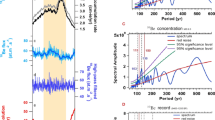Summary
The global distributions of the annual and seasonal means of the diurnal (S 1) and semidiurnal (S 2) surface pressure oscillations are investigated by spherical harmonic analysis. The main waves are,S 1 1 (with wave number 1) forS 1 andS 2 2 forS 2.S 1 1 is much less predominant among the waves ofS 1 thanS 2 2 among those ofS 2. As in the case of the lunar semidiurnal barometric tideL 2 the pressure maxima occur earlier in the Southern than in the Northern Hemisphere. In the case ofS 2 the standing waveS 2 0 and the waveS 2 3 are also of interest besidesS 2 2. Although the present analysis extends only from 60°N to 60°S, whileS 2 0 is largest at polar latitudes, its results show thatS 2 0 should be smaller at high southerly than at high northerly latitudes, as has been observed. Thus this observed asymmetrical distribution ofS 2 0 may be due to causes outside the polar regions rather than to their geographical differences. The best approximation to the observed distribution ofS 2 0 is obtained by including a mode representing an oscillation independent of longitude and latitude indicating a small semidiurnal variation of the mean global surface presure, which is an unlikely result on physical grounds.
The seasonal variation ofS 1 1 expressed in percent of the annual mean is smaller than that ofS 2 2, and both are less than the unexplained seasonal variation ofL 2 2.
The main wavesS 1 1 andS 2 2 are expressed not only by associated Legendre functions, but also by Hough functions.
Similar content being viewed by others
References
J. Bartels,A table of daily integers, seasonal, solar, lunar and geomagnetic, Sci. Rep. No. 2AF 19(604)-503, Geophys. Inst., Univ. Alaska (1954).
S. L. Belousov (transl. by D. E. Brown),Tables of Normalized Associated Legendre Polynomials, (Pergamon Press.; The MacMillan Co., New York, 1962) 379 pp.
S. T. Butler andK. A. Small,The excitation of atmospheric oscillations, Proc. Roy. Lond. A,274 (1963), 91–121.
Th. H. Carpenter,The distribution of the semidiurnal pressure oscillation on the Antarctic continent, J.G.R.68 (1963), 2211–2215.
S. Chapman andR. S. Lindzen,Atmospheric Tides, (D. Reidel Publishing Co., Dordrecht-Holland, (1970), 200 pp.
T. W. Flattery,Hough functions, Tech. Rep. 21 to NSF (Grant NSF-GP-471) Dept. of Geophys., Sci. U. of Chi. (1967).
J. von Hann,Untersuchungen über die tägliche Oscillation des Barometers, Denkschr. Akad. Wiss. Wien, Math.-Nat. Kl.55 (1889), 73 pp.
B. Haurwitz andF. Möller,The semidiurnal air temperature variation and the solar air tide, Arch. Meteorol. Geophys. und Bioklimat., A,8 (1955), 332–350.
B. Haurwitz,The geographical distribution of the solar semi-diurnal pressure oscillation, New York University Meteorol. Papers5, 2 (1956), 1–36.
B. Haurwitz andG. M. Sepúlveda,Geographical distribution of the semidiurnal pressure oscillation at different seasons, Journ. Met. Soc. Japan, 75th Anniv. Vol. (1957), 149–155.
B. Haurwitz andG. M. Sepúlveda,The semidiurnal pressure oscillation in high latitudes, Arch. Meteorol., Geophys. und Bioklimat. A,10, (1957), 29–42.
B. Haurwitz,The diurnal pressure oscillation, Arch. Meteorol. Geophys. und Bioklimat. A,14 (1965), 361–379.
B. Haurwitz andA. D. Cowley,The lumar barometric tide, its global distribution and annual variation, PAGEOPH77 (1969), 122–150.
W. Kertz,Die thermische Erregungsquelle der atmosphärischen Gezeiten, Nachr. Akad. Wiss. Göttingen, IIa, no. 6 (1956), 145–166.
W. Kertz,Partialwellen in den halb-und vierteltärigen atmosphärischen Gezeiten, Arch. Meteorol., Geophys. und Bioklimat. A,11 (1959), 48–63.
B. Lettau,Comments on paper by Thomas H. Carpenter, ‘The distribution of the semidiurnal pressure oscillation on the Antarctic continent’, J.G.R.70, (1965), 3509–3510.
R. S. Lindzen,Thermally driven diurnal tide in the atmosphere, Quart. Journ. Roy. Met. Soc.93 (1967), 18–42.
M. Siebert,Atmospheric Tides, in ‘Advances in Geophysics’17 (Academic Press, New York-London, 1961), pp. 105–187.
G. C. Simpson,The twelve-hourly barometer oscillation, Quart. Journ., Roy. Met. Soc.44 (1918), 1–19.
J. Spar,Characteristics of the semidiurnal pressure wave in the United States, Bull. Am. Meteorol. Soc.33 (1952), 438–441.
M. B. Wilkes,Oscillations of the earth's atmosphere, (Cambridge Univ. Press, 1949) (see p. 14).
A. Schmidt,Tafeln der normierten Kugelfunktionen, (Engelhard-Reyher, Gotba, 1935), 52 pp.
W. Kertz,Atmosphärische Gezeiten, in ‘Handbuch der Physik’48 (Springer-Verlag Berlin, 1957) pp. 928–981.
Additional information
National Center for Atmospheric Research, Boulder, Colorado, U.S.A., sponsored by the National Science Foundation.
Rights and permissions
About this article
Cite this article
Haurwitz, B., Cowley, A.D. The diurnal and semidiurnal barometric oscillations global distribution and annual variation. PAGEOPH 102, 193–222 (1973). https://doi.org/10.1007/BF00876607
Received:
Issue Date:
DOI: https://doi.org/10.1007/BF00876607




